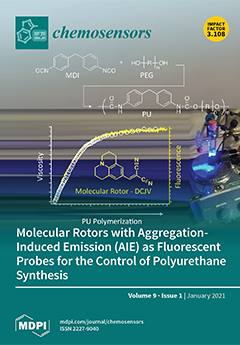Over the past years, to achieve better sensing performance, hafnium dioxide (HfO
2) has been studied as an ion-sensitive layer. In this work, thin layers of hafnium dioxide (HfO
2) were used as pH-sensitive membranes and were deposited by atomic layer
[...] Read more.
Over the past years, to achieve better sensing performance, hafnium dioxide (HfO
2) has been studied as an ion-sensitive layer. In this work, thin layers of hafnium dioxide (HfO
2) were used as pH-sensitive membranes and were deposited by atomic layer deposition (ALD) process onto an electrolytic-insulating-semiconductor structure Al/Si/SiO
2/HfO
2 for the realization of a pH sensor. The thicknesses of the layer of the HfO
2 studied in this work was 15, 19.5 and 39.9 nm. HfO
2 thickness was controlled by ALD during the fabrication process. The sensitivity toward H
+ was clearly higher when compared to other interfering ions such as potassium K
+, lithium Li
+, and sodium Na
+ ions. Mott−Schottky and electrochemical impedance spectroscopy (EIS) analyses were used to characterise and to investigate the pH sensitivity. This was recorded by Mott–Schottky at 54.5, 51.1 and 49.2 mV/pH and by EIS at 5.86 p[H
−1], 10.63 p[H
−1], 12.72 p[H
−1] for 15, 19.5 and 30 nm thickness of HfO
2 ions sensitive layer, respectively. The developed pH sensor was highly sensitive and selective for H
+ ions for the three thicknesses, 15, 19.5 and 39.9 nm, of HfO
2-sensitive layer when compared to the other previously mentioned interferences. However, the pH sensor performances were better with 15 nm HfO
2 thickness for the Mott–Schottky technique, whilst for EIS analyses, the pH sensors were more sensitive at 39.9 nm HfO
2 thickness.
Full article





